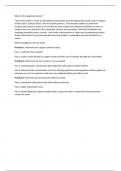Essay
applied science- unit 19 A part 1 - finding the copper content - distinction level
- Institution
- PEARSON (PEARSON)
this is unit 19 A part 1 . it is distinction level graded by my teacher . this will cover : Practical 1: determine the copper content in brass. Part 1: make the brass solution. Part 2: make a series dilution of copper nitrate and then ran all samples through the colorimeter.
[Show more]



